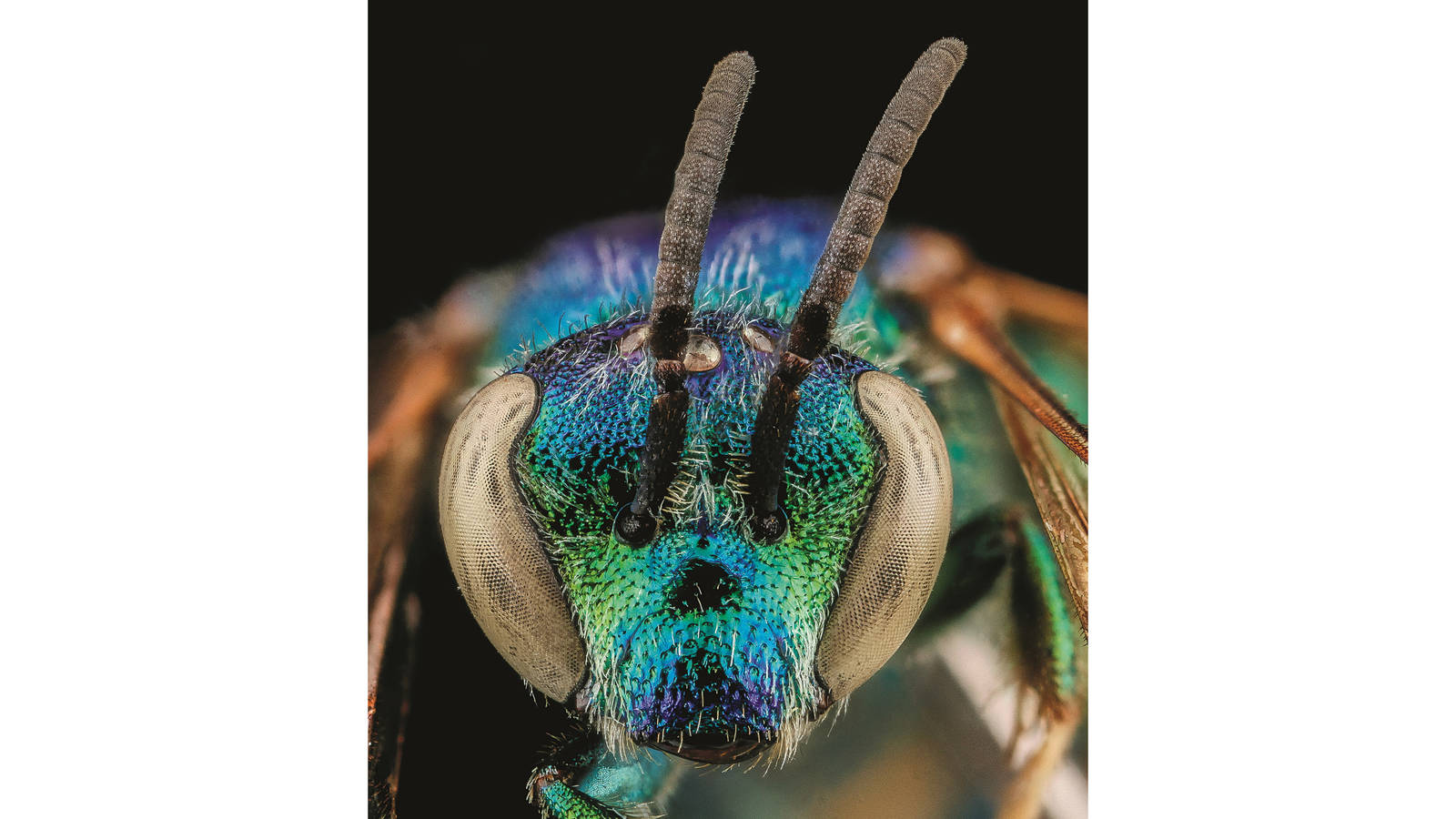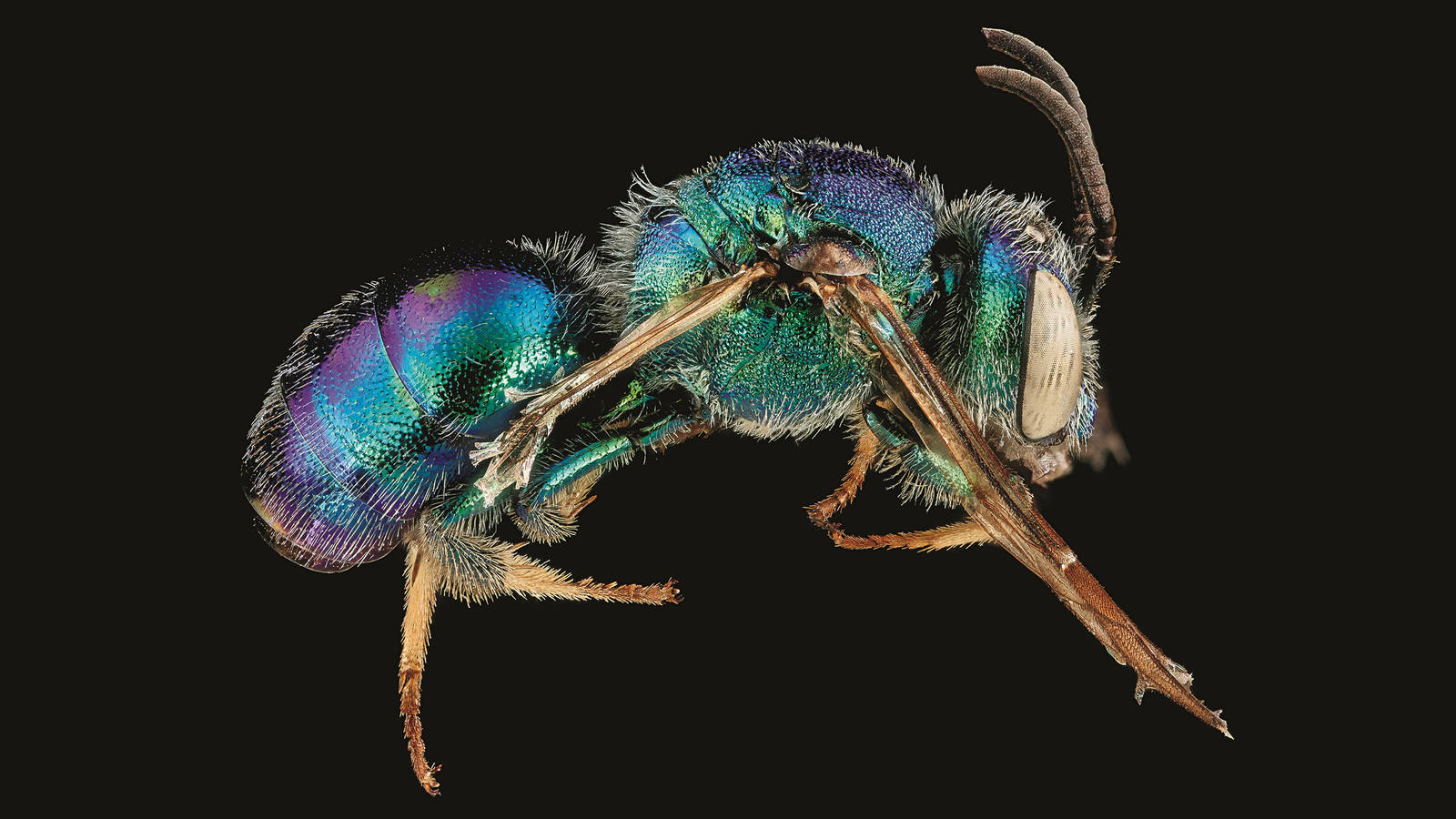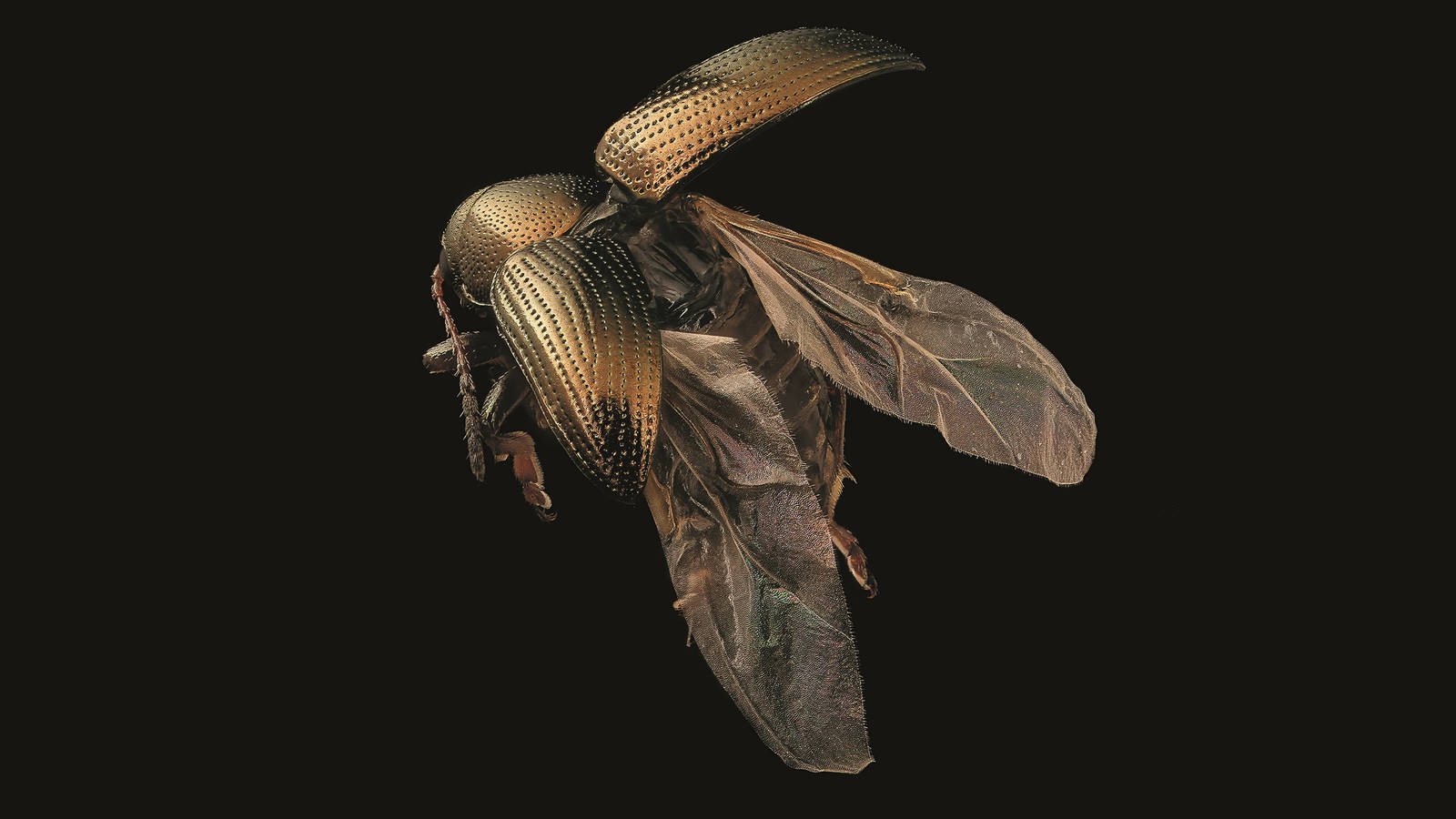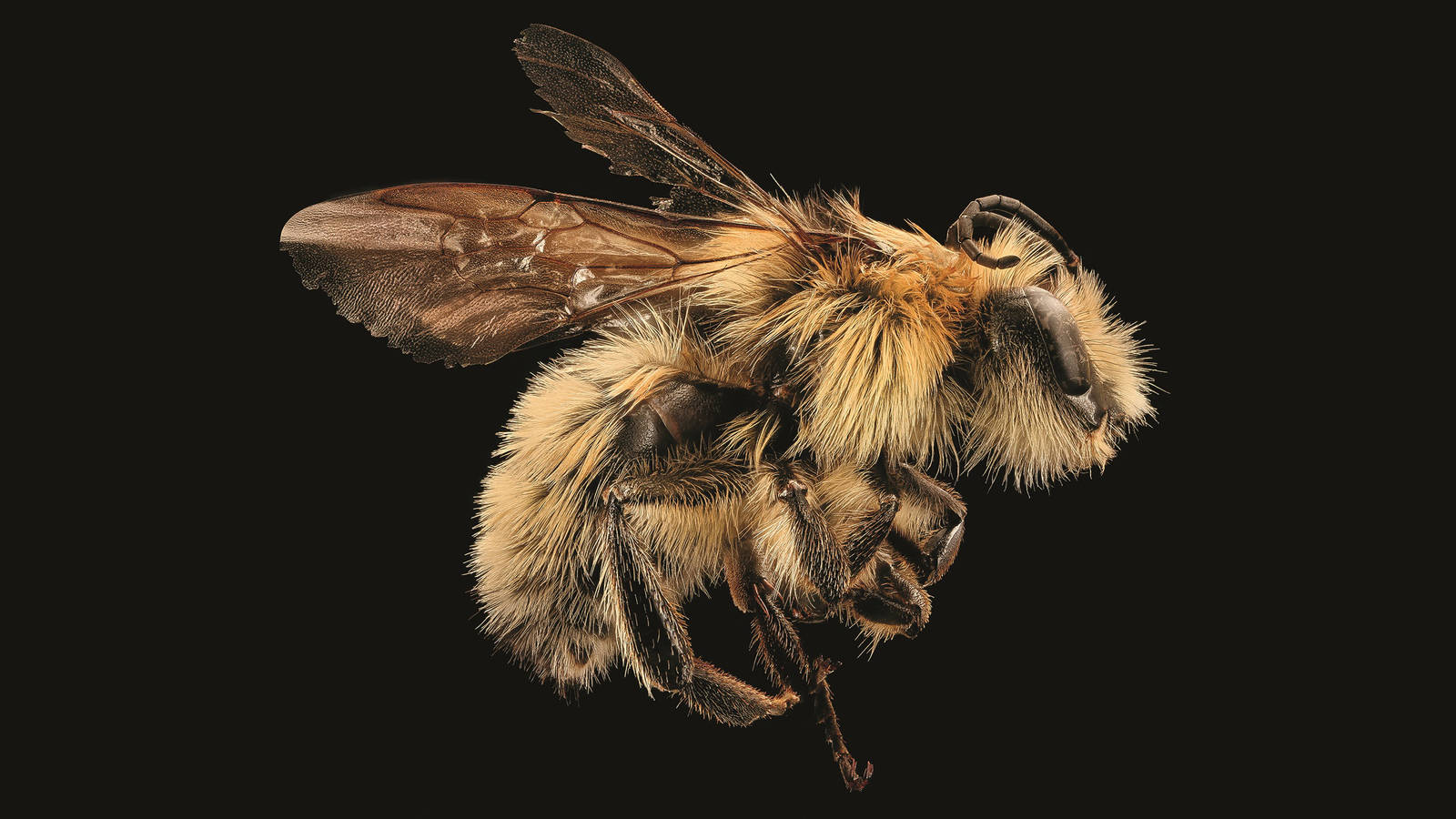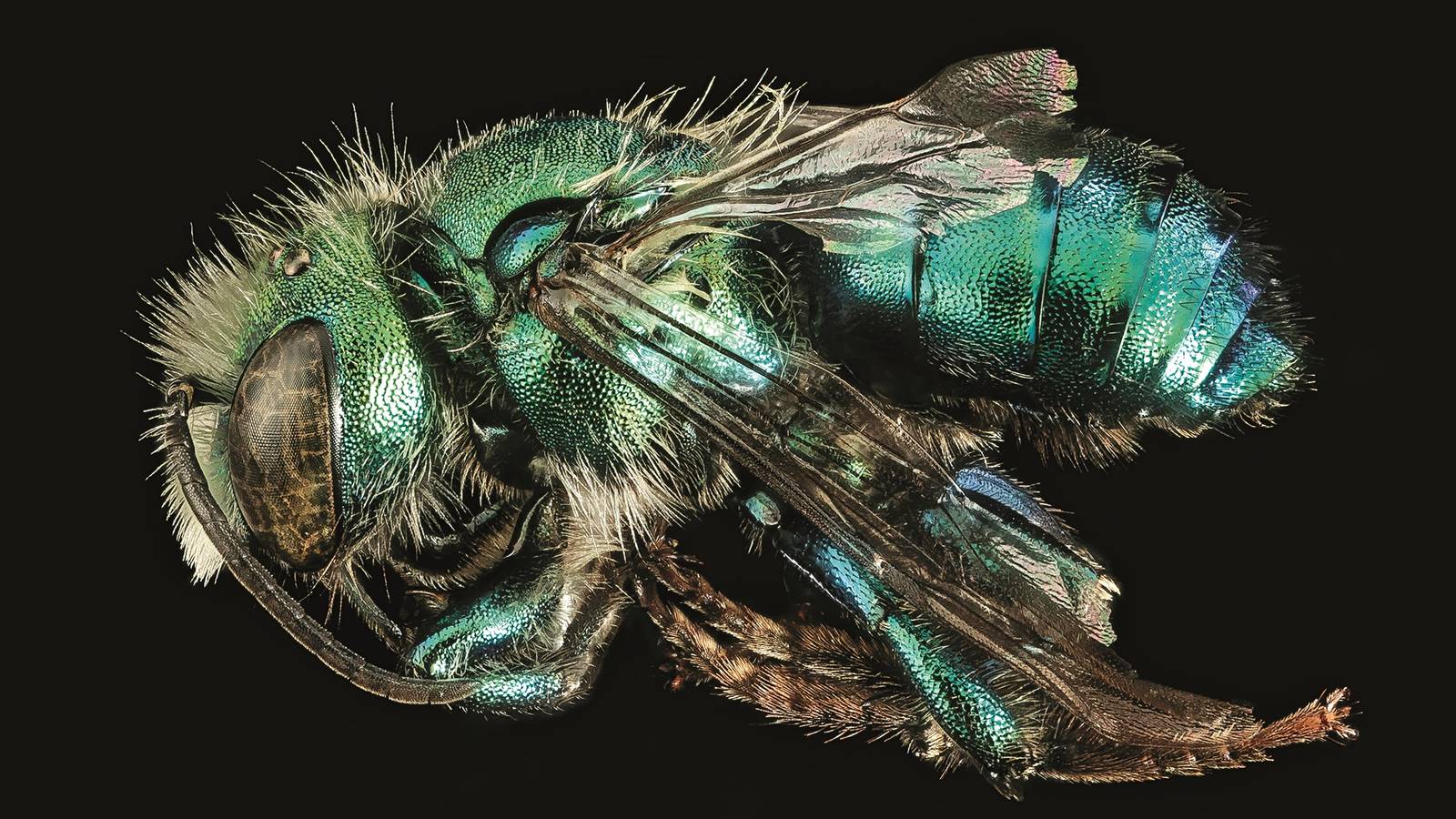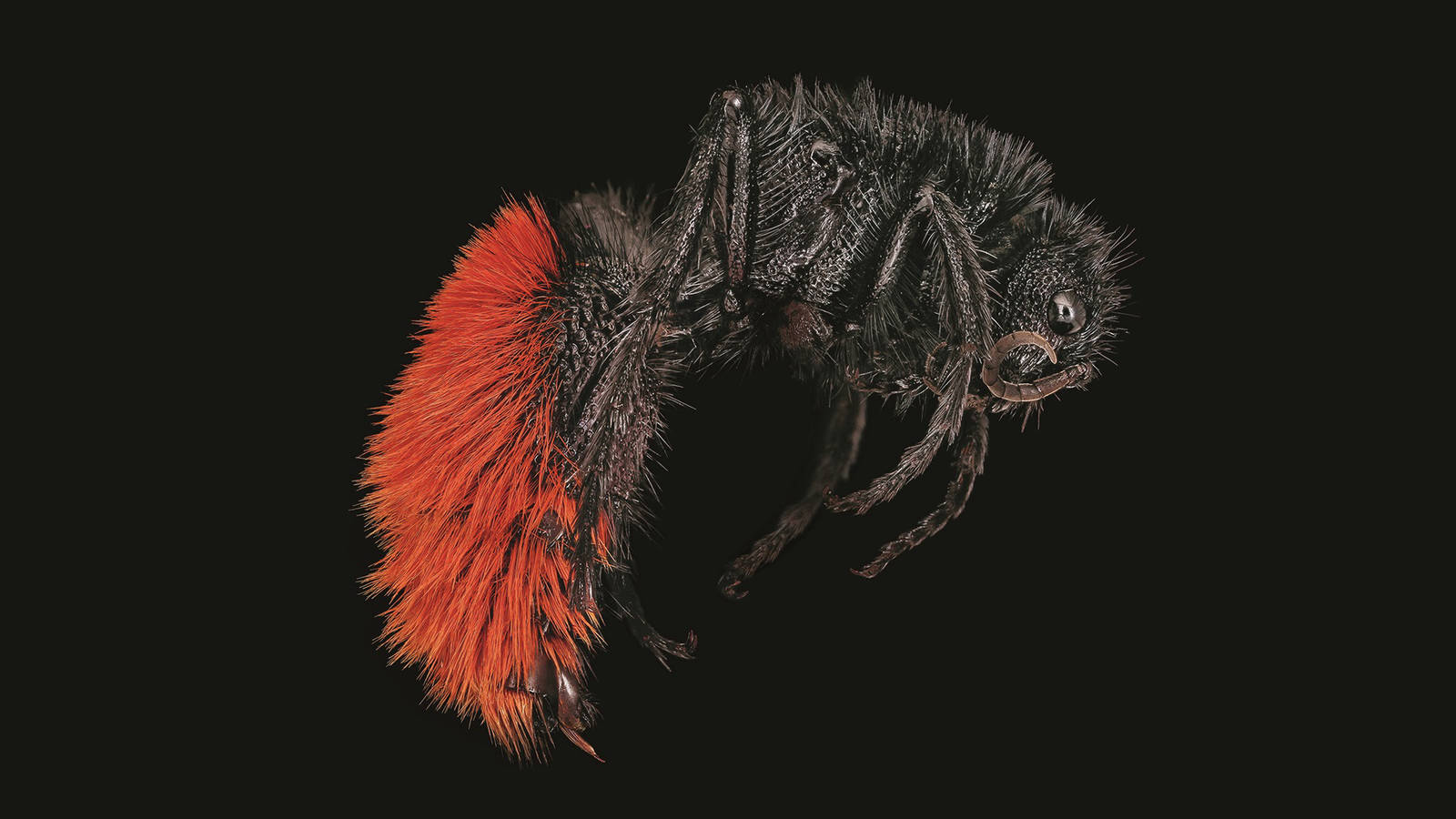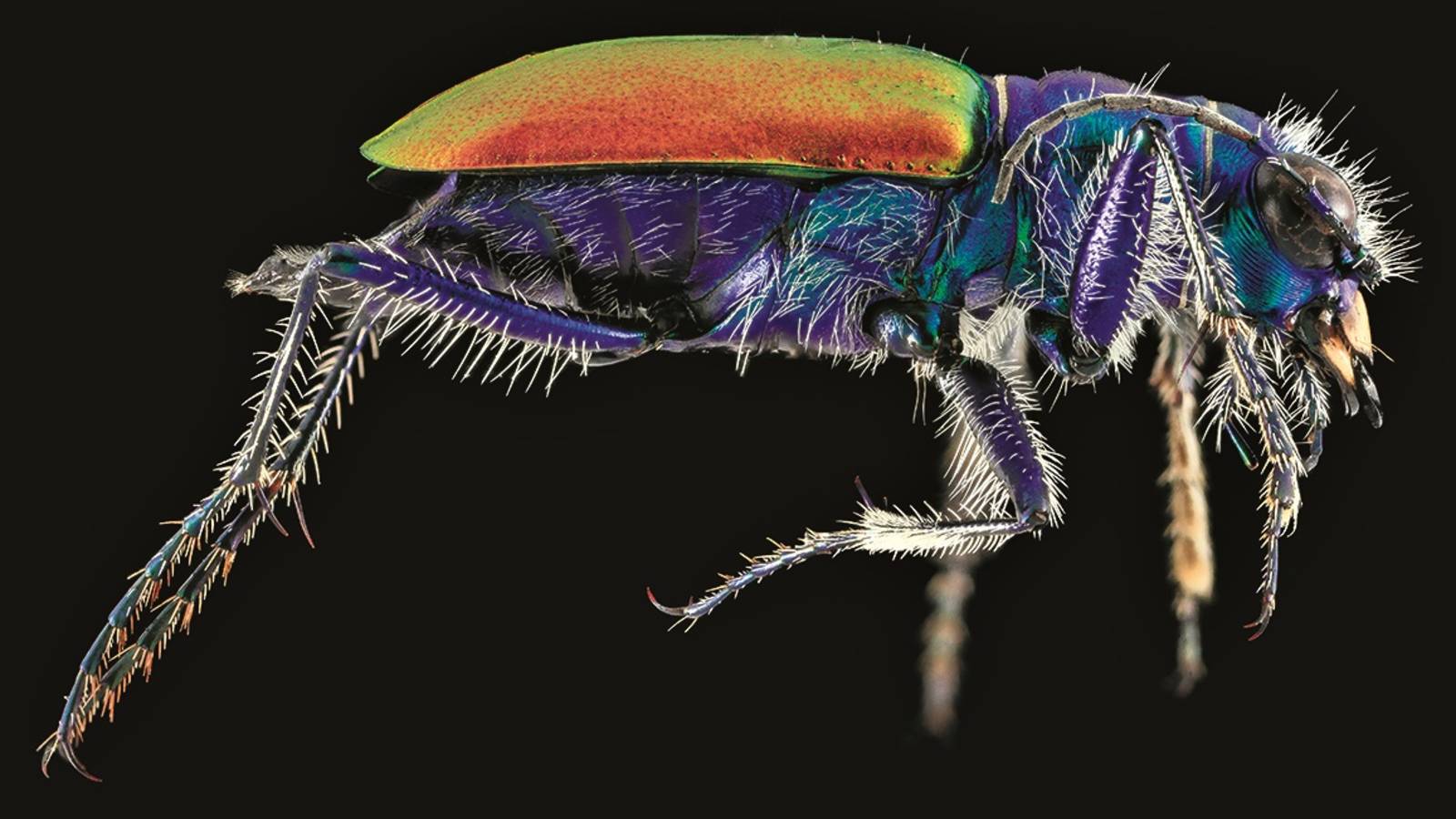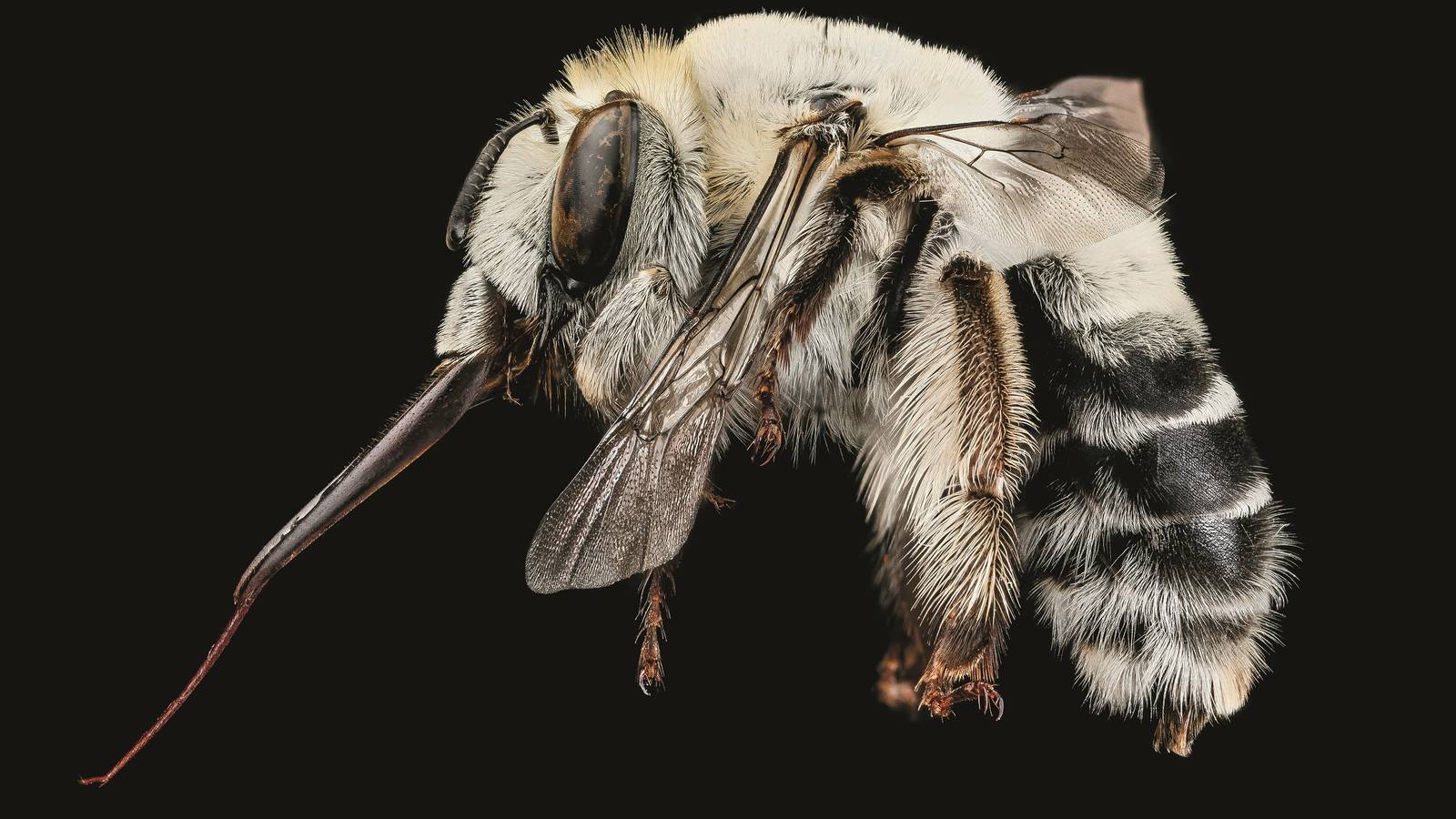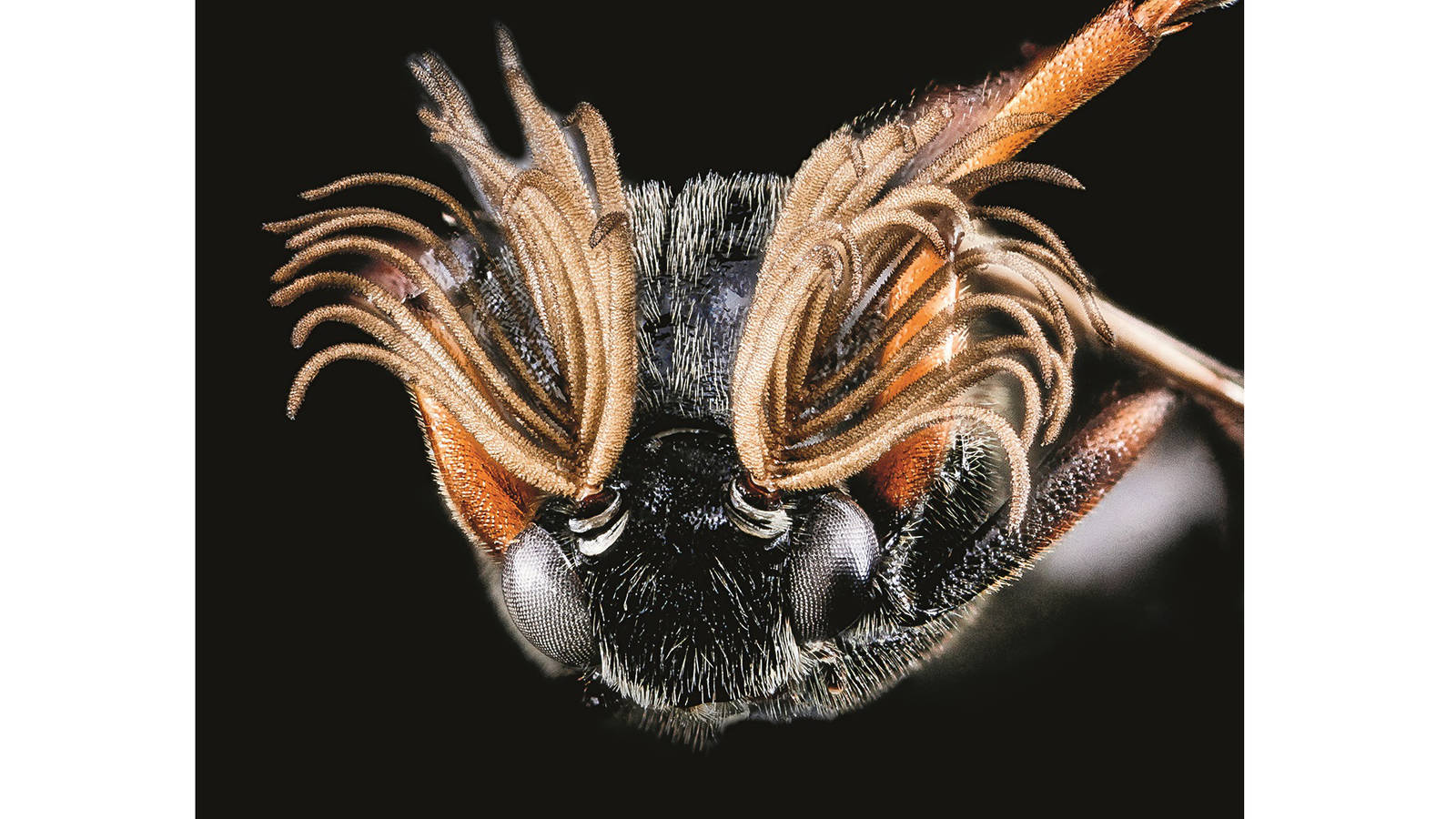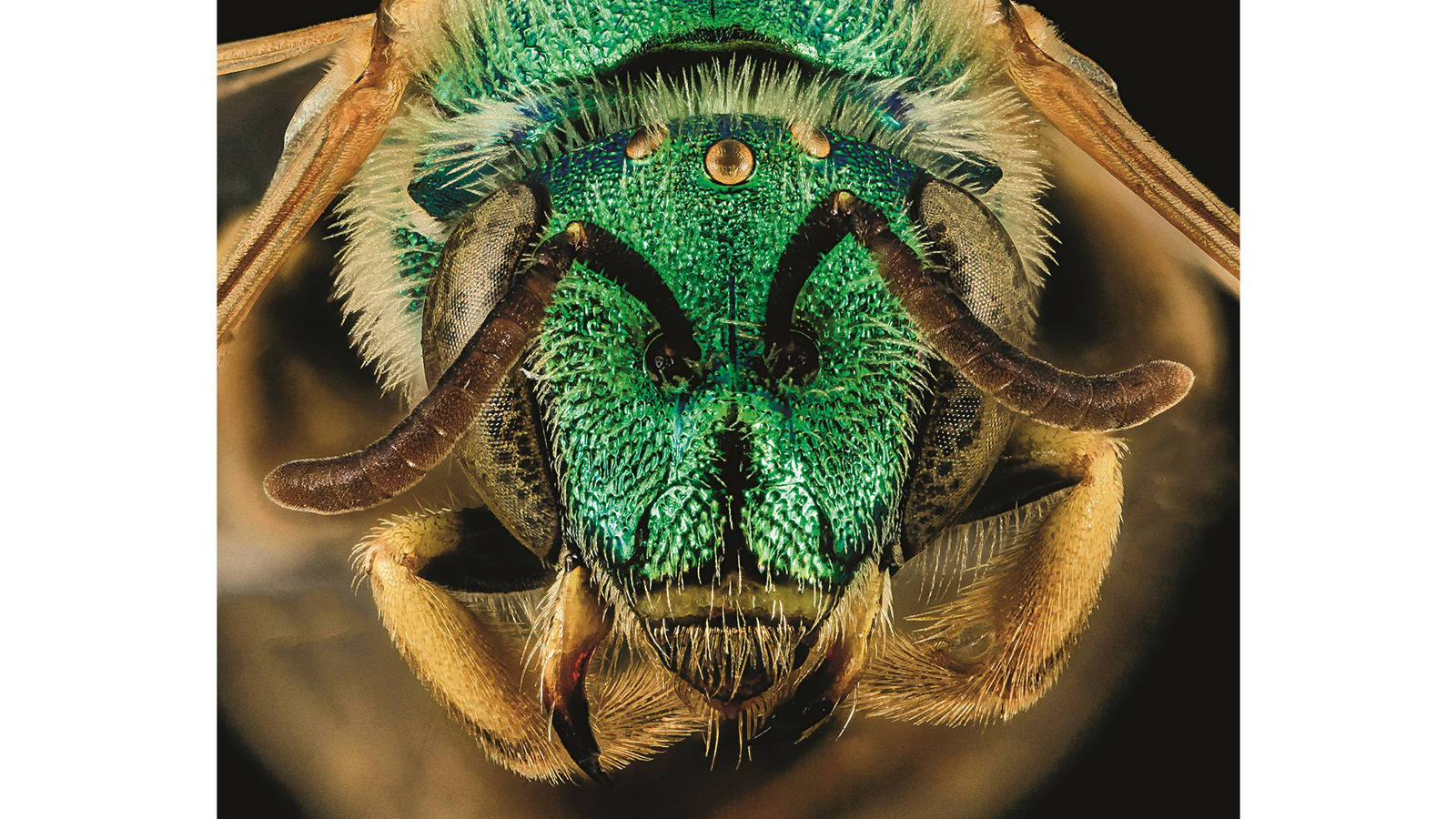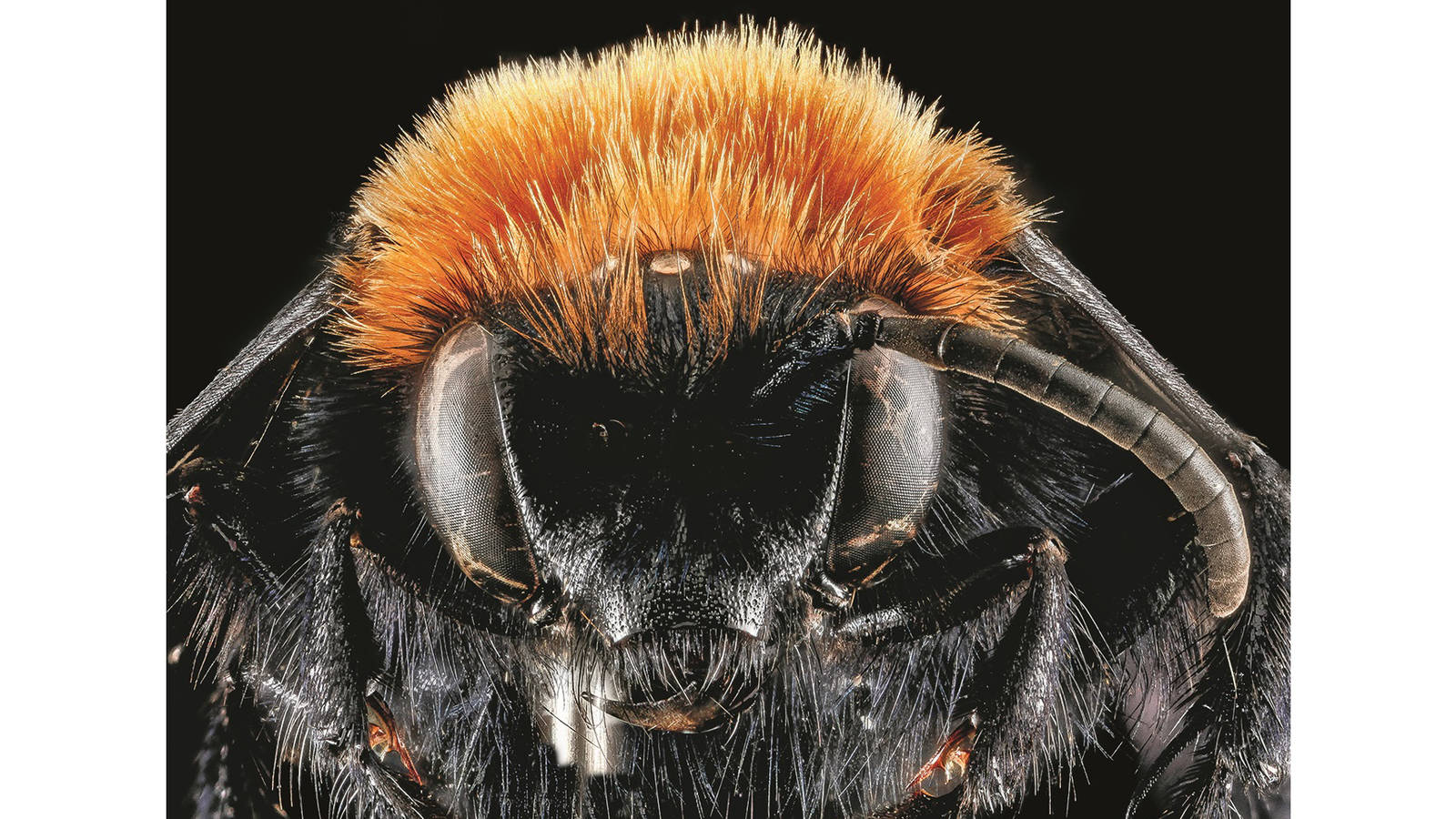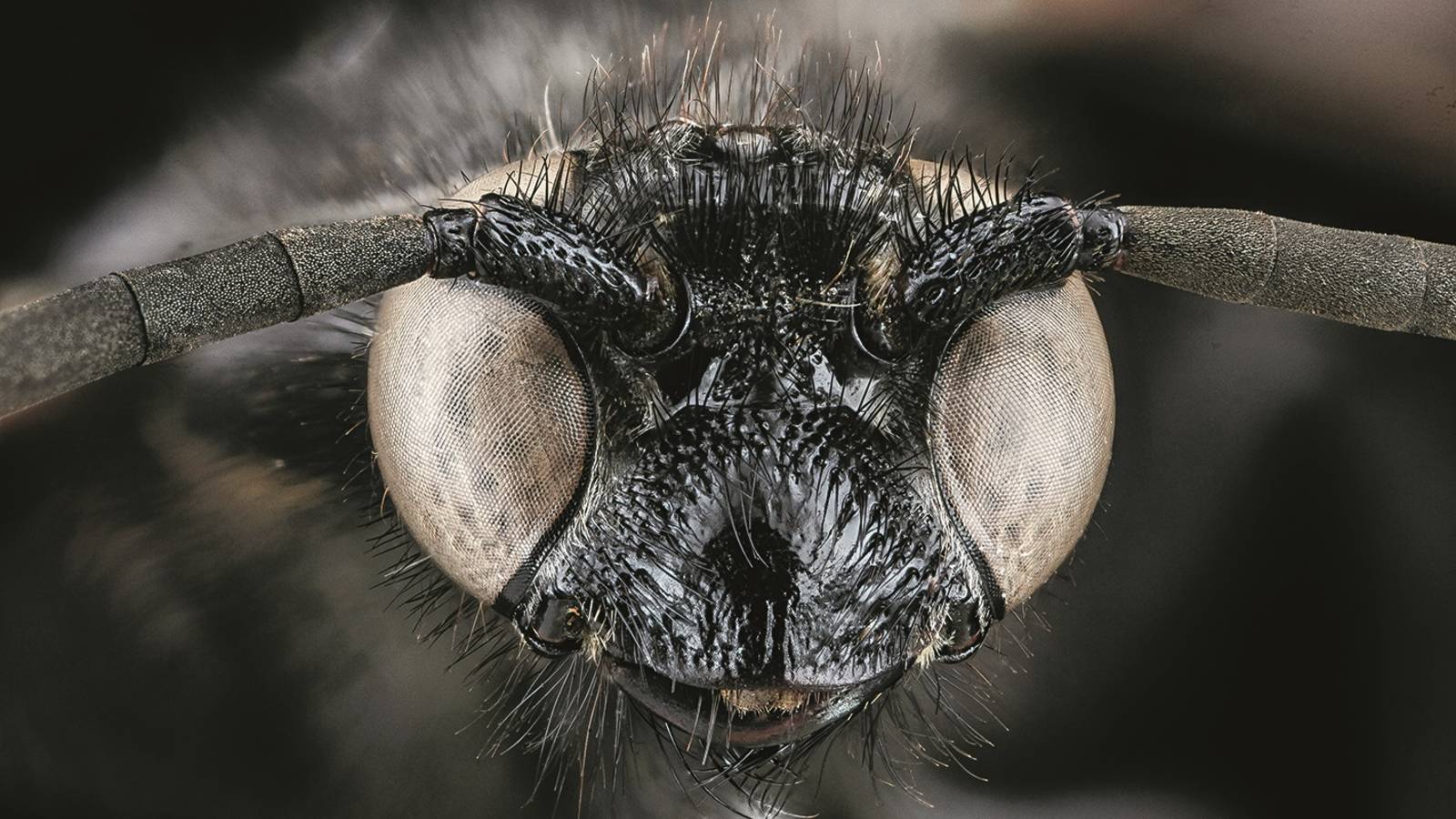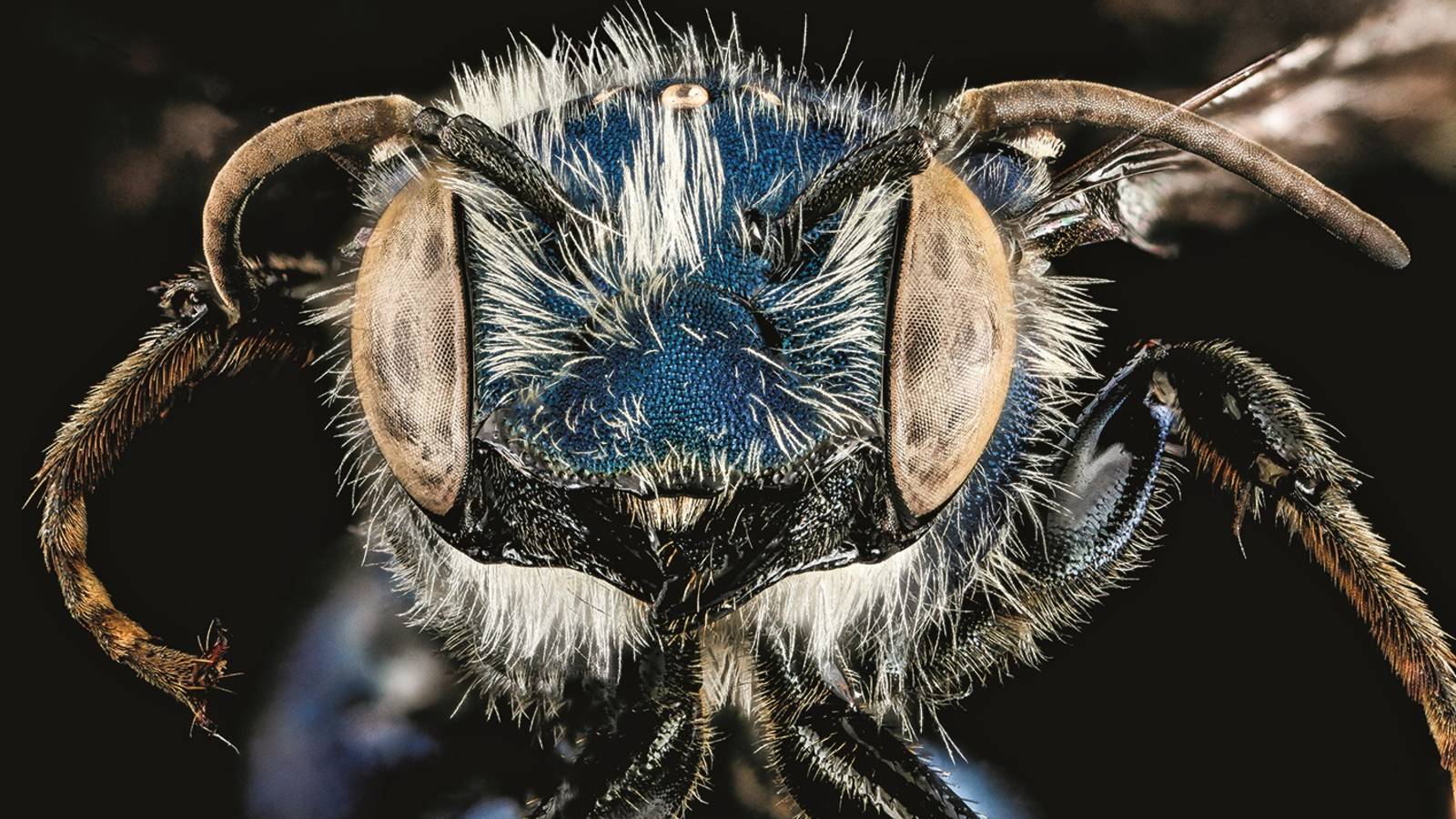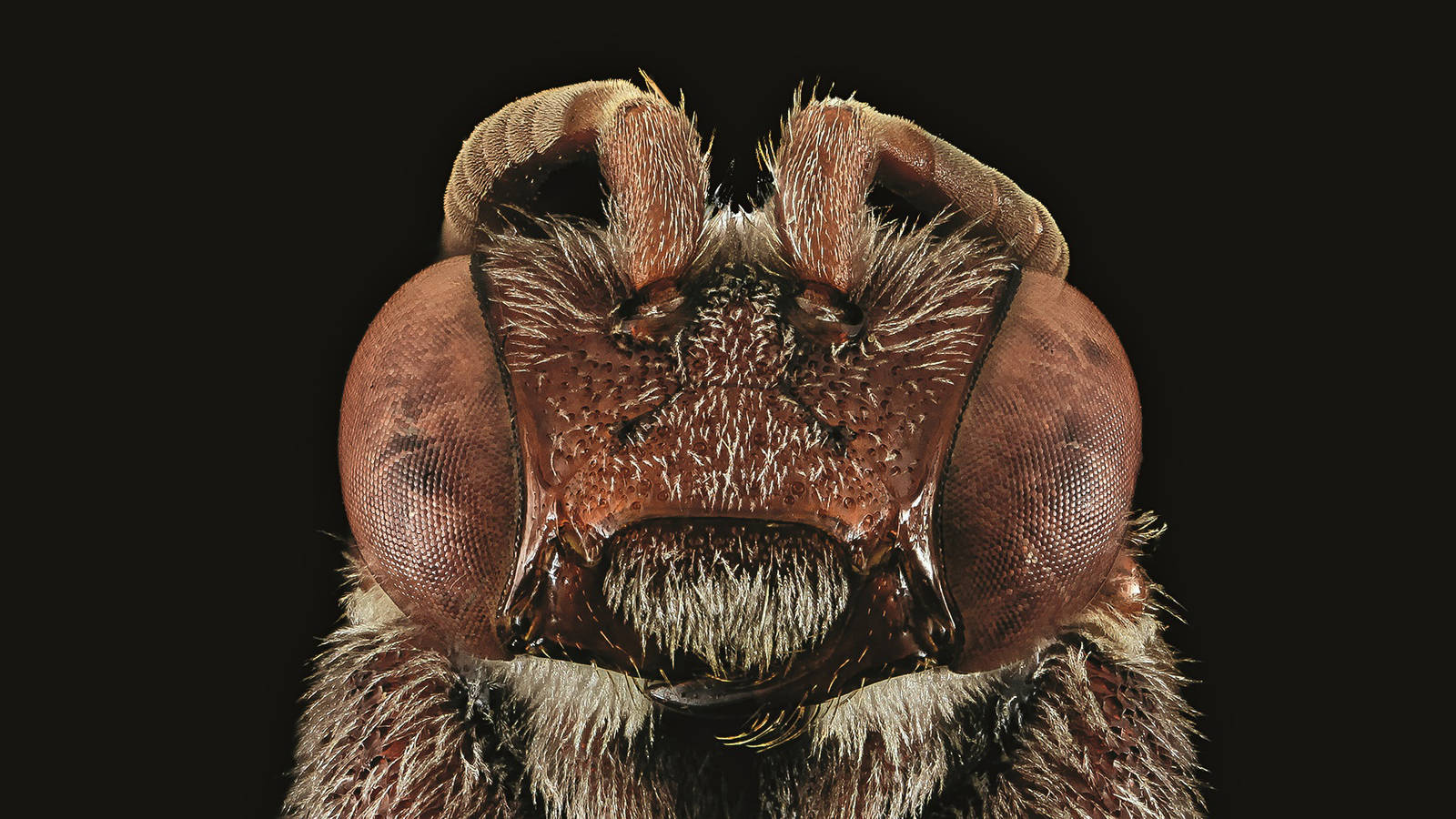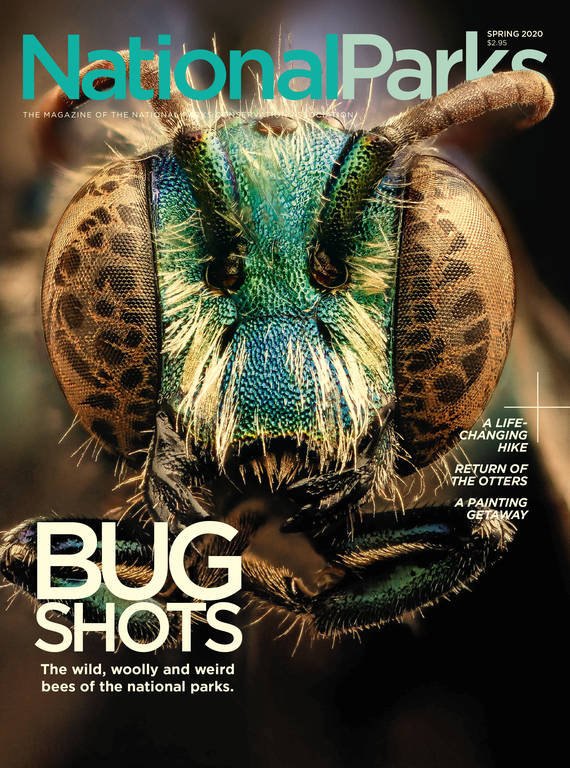Spring 2020
Say Bees!
Sam Droege’s stunning photos of national park insects are the bee’s knees. (And all the other parts, too.)
Sam Droege’s photography studio is tucked inside an old Styrofoam beer cooler. While his models wait for their star turn in front of the camera, some float in hand sanitizer. Others hang out (literally) with recycled acupuncture needles piercing their sleek — or hirsute — bodies. If the setting and props seem to violate labor laws, not to worry. The subjects are all dead. Also, they’re rarely bigger than an average-sized bean.
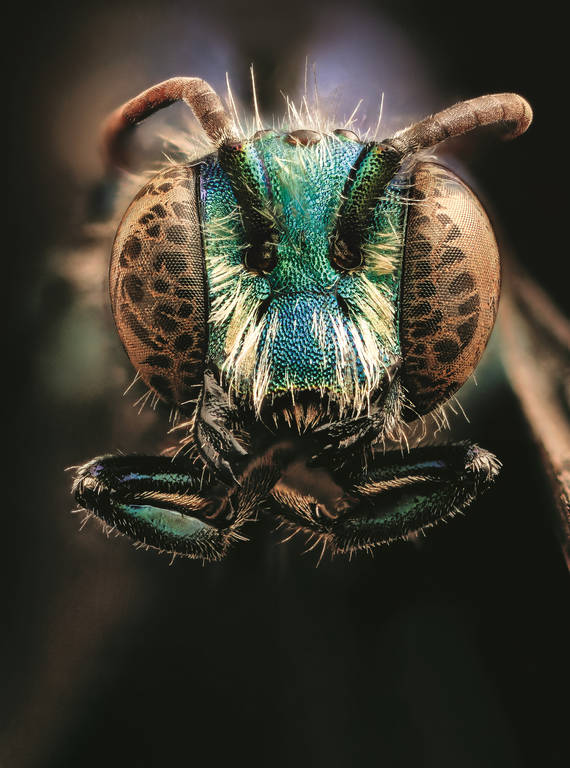
Hoplitis fulgida, a bee found in Yosemite National Park, California.
© ANDERS CROFT/USGS BEE INVENTORY AND MONITORING LABDroege is a 62-year-old career government biologist who knows more about North American bees than just about anybody, but he also considers himself somewhat of an artist. For each bee, wasp or occasional beetle he photographs, he carefully grooms the specimen, endlessly tinkers with its position and adjusts the lighting to avoid any excessive glare from the insect’s exoskeleton.
Most of the bees Droege and his team photograph have little in common with the yellow-and-blackstriped cuties that populate cartoons. They can have woolly-mammoth-style hair or shine like a freshly waxed sports car. Some would not look out of place in a 1970s punk band, while others seem to have just stepped off a “Star Wars” movie set. They come in blue, emerald and orange hues, and their wings sometimes glimmer with all the colors of the rainbow. It is this extraordinary diversity — which matches the diversity in the flowers the pollinators help propagate — that Droege wants to showcase through the thousands of photographs he’s taken and made available to researchers and the public.
“You have to think about this in terms of shapes and colors,” he said on a recent rainy morning in his lab at the Patuxent Wildlife Research Center in Maryland. “If I’m spending all this time, I’m going to make something beautiful.” Droege, who has a background in statistical analysis, has developed survey protocols and monitoring programs for birds, amphibians, dragonflies, fungi and eight-legged micro-animals known as tardigrades or water bears. A couple of decades ago, he and a colleague came up with the idea of the BioBlitz, which brings together scientists and lay visitors to inventory species. The event, which started at Kenilworth Park and Aquatic Gardens in Washington, D.C., has since become extremely popular and now takes place at locations around the world including many U.S. national park sites.
Augochloropsis anonyma (bee), Biscayne National Park, Florida. © SAM DROEGE/USGS BEE INVENTORY AND MONITORING LAB
Augochloropsis anonyma (bee), Biscayne National Park, Florida. © SAM DROEGE/USGS BEE INVENTORY AND MONITORING LAB
Leaf beetle (species unknown), Kenilworth Park and Aquatic Gardens, Washington, D.C. © SYDNEY PRICE/USGS BEE INVENTORY AND MONITORING LAB
.
Bombus vandykei (bumblebee), Yosemite National Park, California. © SAM DROEGE/USGS BEE INVENTORY AND MONITORING LAB
Osmia bruneri (bee), Yellowstone National Park, Wyoming. © ELIZABETH GARCIA AND WAYNE BOO/USGS BEE INVENTORY AND MONITORING LAB
Mutillid wasp (species unknown), Great Basin National Park, Nevada. © SAM DROEGE/USGS BEE INVENTORY AND MONITORING LAB
Cicindela scutellaris (festive tiger beetle), Badlands National Park, South Dakota. © SAM DROEGE/USGS BEE INVENTORY AND MONITORING LAB
Anthophora affabilis (bee), Badlands National Park, South Dakota. © SAM DROEGE/USGS BEE INVENTORY AND MONITORING LAB
Ripiphorus beetle (species unknown), Great Smoky Mountains National Park, Tennessee. © SAM DROEGE/USGS BEE INVENTORY AND MONITORING LAB
Agapostemon melliventris (bee), Badlands National Park, South Dakota. © SAM DROEGE/USGS BEE INVENTORY AND MONITORING LAB
Melecta bee (species unknown, although Sam Droege jokingly labeled it “Billy Idol Melecta” after the 1980s rock star), Fossil Butte National Monument, Wyoming. © SAM DROEGE/USGS BEE INVENTORY AND MONITORING LAB
Scolia bicincta (wasp), Cape Cod National Seashore, Massachusetts. © SAM DROEGE/USGS BEE INVENTORY AND MONITORING LAB
Osmia chalybea (bee), Cumberland Island National Seashore, Georgia. © SAM DROEGE/USGS BEE INVENTORY AND MONITORING LAB
Nomada australis (bee), Gateway National Recreation Area, New York. © BROOKE ALEXANDER/USGS BEE INVENTORY AND MONITORING LAB
Droege started his bees work in 2001, at a time of growing concerns over the decline in pollinators. He makes a point of distinguishing what is troubling honeybees — nonnative bees whose colonies are experiencing mysterious collapses — from the situation of native bees, which rarely make honey and tend to live in individual nests. North America counts about 4,000 species of bees. Undoubtedly, some of the indigenous species are also suffering declines — the rusty patched bumblebee and seven species of yellow-faced bees native to Hawaii have been listed under the Endangered Species Act in recent years — but for most native bees, scientists have very little information of any kind, let alone population trend data.
“We’re about 100 years behind the bird people, and many years behind the butterfly people,” Droege said.
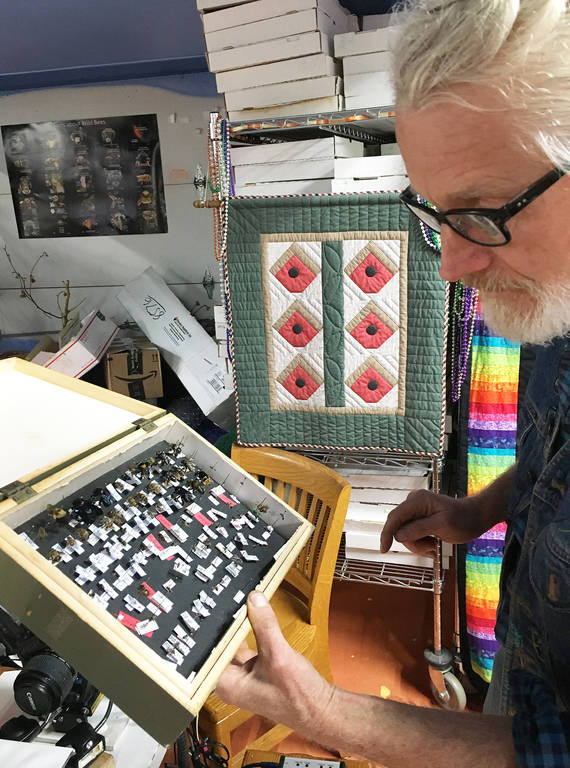
Sam Droege in his lab.
© NICOLAS BRULLIARD/NPCADroege has tried hard to catch up. Given the dearth of bee taxonomists, he sort of fashioned himself into one. He and his colleagues at the U.S. Geological Survey’s Bee Monitoring and Inventory Lab have identified about 500,000 specimens that passed through the lab’s doors and added information including the species name and the collection location to their database. Droege collected some of the bees himself near his Maryland home, on vacation travel or during research trips (including a project to survey coastal bees at national park sites a few years ago), but most insects were sent to the lab by researchers, graduate students and even some of Droege’s friends and neighbors.
While Droege enjoys identifying bees (he spent much of the government shutdown a year ago doing just that), he realized early on that it was crucial to provide others with the tools to do it themselves. He decided to create high-resolution photographs of each kind of bee so that researchers could compare them with the specimens they were trying to identify. After determining which bees live where, scientists can then monitor populations over time and find out whether a particular species is at risk.
Getting the sort of detailed pictures that researchers can use is an extraordinarily time-consuming process. (Droege takes a lot of the photos himself, but he’s trained technicians and volunteers to help.) Most bees arrive at the lab floating in alcohol or other liquids, so their wings are often stuck together or their hair is matted. To clean them up, Droege usually takes them home and dumps them in the washing machine with a little bit of laundry detergent. He then throws the wet bees in the lab’s dryer and sets it on high. Bees are surprisingly resistant to tumbling, but he checks on them periodically to make sure they don’t get too dry. “If they start getting a little crispy, then their antennas snap off,” he said.
One of Droege’s worst nightmares is bad bee hair, so to give his bees a nice, fluffy finish, he uses a small compressor with an airbrush valve — the kind of device designed to apply paint to model airplanes. Another pesky issue is that bees are dust magnets, so Droege will lick a pin and remove specks of dust one by one while viewing a bee through his microscope lens. Once his model is finally ready for the photo shoot, Droege places it inside an upside-down beer cooler that he’s lined with black velvet and outfitted with an opening for a lens. Inspired by a method developed by the U.S. Army to document disease-carrying insects, he takes a series of pictures while moving the camera on a sliding rail toward his subject. With the help of image-processing software, Droege stacks the shots to give a three-dimensional appearance to the final image. (If the bee were to move at any point during the photo shoot, the resulting image would be blurry, which is why Droege only photographs dead insects.) He typically photographs the face, back and side of a bee but will add different angles if needed. The whole shoot can take upward of two hours.
“If I’m spending all this time, I’m going to make something beautiful.”
Once he has photographed a bee, Droege crushes it through his fingers and scrapes the guts off the pin, which he washes for future use. “We’re not a museum,” he said. “We’re a database.”
Almost 10 years ago, he started uploading his bee photos on Flickr, the photo-sharing website. He thought his primary audience would be scientists, but one day his daughter told him some of his bee pictures had been posted on a popular social media account. They had garnered more than 200,000 views and generated scores of humorous online comments about how the bees looked like Power Rangers, “bad mama jamas” and the love children of interspecies affairs. “Hmmm I didn’t know they came in blue, green, grey and death,” one person wrote. “Oh so those were real?” another joked (or maybe just asked).

National Parks
You can read this and other stories about history, nature, culture, art, conservation, travel, science and more in National Parks magazine. Your tax-deductible membership donation of $25 or more entitles…
See more ›“These were not my people,” Droege said. “These were the general public.” He has since created an Instagram account that has accrued a respectable number of admirers. “We’re not up there with movie stars, but we have more than 18,000 followers,” he said. He has now posted more than 4,000 photos on Flickr, including nearly 700 of insects collected — with the proper permits — at national park sites. (All the photos included in this essay and slideshow feature national park specimens.)
The work is far from over. On every shelf of his lab lie piles of pizza boxes filled with pinned bees waiting to be processed. Droege estimates the backlog at about 100,000 bees, and more will keep coming.
“It will be years before we get close to everything done,” he said before pausing briefly. “And what does ‘everything’ mean anyway?”
About the author
-
 Nicolas Brulliard Senior Editor
Nicolas Brulliard Senior EditorNicolas is a journalist and former geologist who joined NPCA in November 2015. He serves as senior editor of National Parks magazine.
